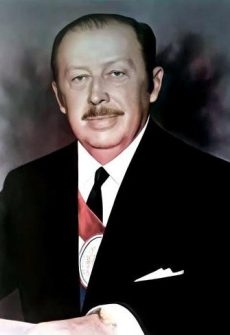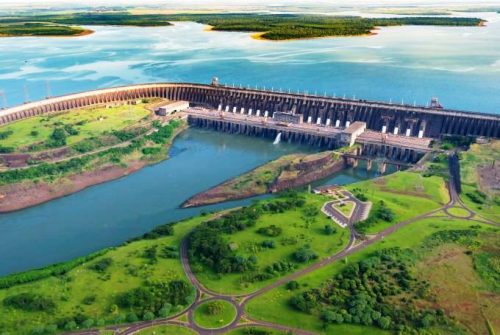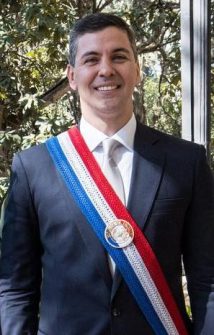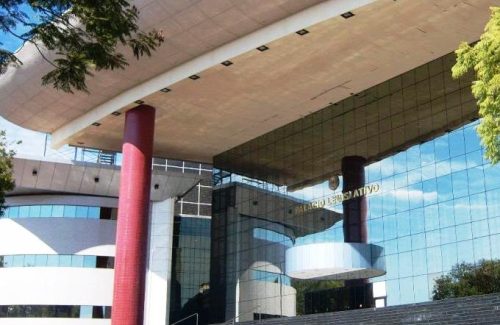A tortuous political journey.

After the catastrophic war against the Triple Alliance, the country was crisscrossed by bitter political struggles and episodes of civil war between gangs, supported by Brazil and Argentina, who competed for the division of the Paraguayan territory.
The Colorado party was in power and governed uninterruptedly from 1870 to 1904 when it was ousted by the victory of the liberals who remained there until the Chaco war of 1932, won by Paraguay. In the following years, the country was overwhelmed by a militarist wave, with coups d’état soon followed by civil wars and armed clashes, until reaching the coup of 1954 which ensured Alfredo Stroessner, head of the Colorado party, power for thirty-five years.

Alfredo Stroessner. He was president from 1954 to 1989. CC BY-SA 4.0/TheStronista1954.
Stroessner, who was initially supported by the Argentine president Juan Domingo Perón, initially enjoyed broad popular consensus which was shattered between 1958 and 1962 with the growth of the phenomenon of armed struggle, carried out largely by Paraguayan exiles in Argentina whose intent was to establish a true democratic government.
From an economic point of view, Stroessner took measures aimed at a more equitable distribution of wealth which, however, proved ineffective. These included the expropriation of enormous quantities of land which, in a short space of time returned to the hands of large landowners, as the farmers, without the tools for processing and adequate resources, were forced to sell their lands. During his presidency, the Itaipú dam was also built which, even if it immediately guaranteed an impetus to the country’s economy with economic growth of 9% per year – the highest in Latin America, these effects proved to be short-lived due to the burdensome foreign debt.

Aerial view of the Itaipu Hydroelectric Dam on the Parana River. It was built under Stroesser’s presidency. Shutterstock/Jose Luis Stephens
A new Constitution was also passed which, not providing for any maximum limit on the re-election of the President, allowed Stroessner to remain in power until 1989, the year in which the strength of the opposition became evident also due to the profound economic crisis. This created the conditions for a new coup d’état which gave power into the hands of Andrés Rodríguez, Stroessner’s father-in-law. Rodríguez, animated by democratic intentions, prepared the ground for the 1993 elections which began a period of democratic stability in which the Colorado Party almost always had the upper hand in the electoral consultations. These electoral affirmations were also determined by the fact that the Paraguayan elites, as Federico Larsen clearly highlights, have historically had a conservative and traditionalist imprint. This applies both to the revolutionary aristocracy that led the independence process of 1811 and to the military, civil and ecclesiastical groups that supported the dictatorship of Alfredo Stroessner.
On closer inspection, in fact, the nationalist conservatives governed the country without interruption for 61 years – supporting General Alfredo Stroessner for 35 years – and precisely until 2008, the year in which the unprecedented administration of centre-left took power, chaired by Fernando Lugo. Except the Lugo parenthesis, Paraguay was, in fact, the only country in the southern cone not to be involved in the waves of progressive governments that swept the region at the beginning of the 20th century, in the 1940s and in the early 2000s.

Santiago Peña Palacio, president of Paraguay since 2023.
The success of the conservatives was also confirmed in the electoral round of last April 30 with the affirmation of Santiago Pena of the Colorado party who obtained 42.74 percent of the votes, more than 1.29 million, as against 27.49 percent for Alegre. In third place was the ultra-conservative leader Payo Cubas, candidate of the National Crusade, with 22.92 percent of the vote, thus proving to be the surprise of the electoral round. During the electoral campaign, the issue relating to relations with Taiwan and the renewal of the agreements with Brazil, for the management of Itaipú, which expired last August, was heavily debated. Paraguay is one of the few countries in the world to recognize Taiwan and not the People’s Republic of China. This factor is of crucial importance for the United States given that if Paraguay were to change front it would make possible the opening of negotiations for a free trade agreement between China and Mercosur, a topic that has been debated for years between the four member countries of the organization also following the impressive Chinese economic penetration in Latin America. Paraguay, however, is skilled in using this leverage both in relations with the United States, which is the country’s largest economic donor, and with Taipei which guarantees it the technology to improve its monitoring of the Paraná basin. Regarding relations with Brazil, the two countries find themselves at a crucial point in which they are about to start negotiations for the renewal of the dam management contracts.
In this regard, during a bilateral meeting last July between the two Presidents Peña and Lula, the need for progress was highlighted: in the integration of production chains and transport infrastructure, including the river routes in the Paraná basin and the interoceanic corridor, and in the EU Mercosur agreement.

The legislative building in Asunción. CC BY-SA 4.0/Cryaven
The current geopolitical posture of the country is in continuity with that assumed in the past in which it held, together with Uruguay, a role as a buffer country to avoid regional integration and, in particular, between Argentina and Brazil. In this regard, Larsen cites two examples from recent history that give a good idea of the objectives pursued by the country: the first concerns the construction of dams for electricity generation near the Triple Border (with Argentina and Brazil) in the seventies, which allowed Asunción to carve out a certain strategic importance by fuelling the rivalry between Brasilia and Buenos Aires; while the second concerns the entry of Hugo Chávez’s Venezuela into Mercosur – greatly desired by Lula and the then Argentine president Cristina Kirchner, but rejected by the Paraguayan parliament – which was only possible after the suspension of Paraguay from the organization, as it was deemed an anti-democratic country, due to the impeachment of Fernando Lugo carried out by the Chambers in 2012. (Open Photo: Lopez presidential palace at night in Asuncion, Paraguay capital. Shutterstock/Paulo Nabas)
F.R.



